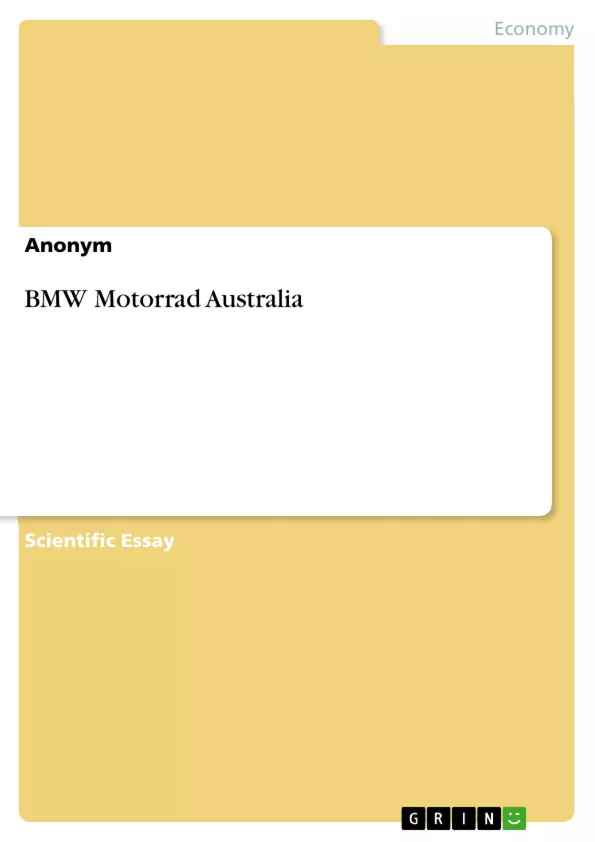1.4 Theory - Stakeholder
...
“any group or individual who can affect or is affected by the achievement of the organization’s objectives”. Sharma and Starik (2004, p. 16) maintain that “Stakeholders […] exist at different organizing levels and according to Phillips (2003, p. 13), each organization identifies different stakeholders. Phillips (2003, p. 16) argues that stakeholder theory deals with moral principals and that it is important to pay attention to “the interests and well-being of those who can assist or hinder the achievement of the organization’s objectives”.
Phillips (2003, pp. 28-29) distinguishes normative and derivative stakeholders:
Normative stakeholders are those to whom the organization has a direct moral obligation to attend to their well-being […] such as financiers, employees, customers, suppliers, and local communities. Alternatively, derivative stakeholders are those groups or individuals
...
1.5 Identify stakeholders
According to the Glossary of BMW Group, the company’s stakeholders are “primarily customers, employees and shareholders and special interest groups, as well as municipalities worldwide where the BMW Group operates” (Sustainable Value Report, 2008).
...
Table of Contents
- Introduction
- Who is the organization
- Organizational Structure
- Industry & Activities
- Theory - Stakeholder
- Identify stakeholders
- Conclusion
Objectives and Key Themes
This assignment analyzes BMW Motorrad Australia, focusing on its organizational structure, activities, and stakeholder relationships. The main objective is to provide an overview of the company, its role within the BMW Group, and its impact on the Australian motorcycle market.- Organizational structure and activities of BMW Motorrad Australia
- Application of stakeholder theory to identify key stakeholders of BMW Motorrad Australia
- The impact of BMW Motorrad Australia on the Australian motorcycle market
- The role of BMW Motorrad Australia within the broader BMW Group
- The responsibilities of BMW Motorrad Australia regarding policy, legislation, and the environment
Chapter Summaries
Introduction
This chapter introduces BMW Motorrad Australia, providing a brief overview of the company, its history, and its place within the broader BMW Group. It also discusses the organization's structure, key activities, and its role in the Australian motorcycle market.Who is the organization
This section delves into the origins of BMW, highlighting its international presence and its position as a leading producer of cars and motorcycles. It specifically focuses on BMW Motorrad Australia as the distributor of BMW motorcycles in the Australian market.Organizational Structure
This section examines the organizational structure of BMW Motorrad Australia, detailing its headquarters location, key personnel, and management structure. It also highlights the company's reliance on knowledge and strategies derived from other subsidiaries of the BMW Group.Industry & Activities
This section explores the main business interests of the BMW Group, emphasizing its focus on automotive concerns, motorcycles, and financial services. It further clarifies the primary objective of BMW Motorrad Australia – to market and sell BMW motorcycles in Australia.Theory - Stakeholder
This section introduces the concept of stakeholders, drawing upon established definitions and theories. It distinguishes between normative and derivative stakeholders, highlighting the importance of considering the interests of all groups that can affect or be affected by the organization.Identify stakeholders
This section identifies the key stakeholders of BMW Motorrad Australia, categorizing them into normative and derivative groups. It discusses the specific relationships and obligations that BMW Motorrad Australia has with each stakeholder group, including customers, authorized dealers, employees, and competitors.Conclusion
This section summarizes the key insights gleaned from the analysis of BMW Motorrad Australia. It reinforces the company's position as a leading force in the Australian motorcycle market and emphasizes the importance of maintaining a strong reputation and satisfied stakeholders.Keywords
This assignment explores the organizational structure and stakeholder relationships of BMW Motorrad Australia, a key subsidiary of the BMW Group, within the context of the Australian motorcycle market. The assignment focuses on key themes such as organizational structure, stakeholder theory, normative and derivative stakeholders, brand reputation, and market leadership. Key terms include BMW Motorrad Australia, BMW Group, stakeholder analysis, authorized dealers, customers, employees, competitors, environmental responsibilities, and market share.- Arbeit zitieren
- Anonym (Autor:in), 2010, BMW Motorrad Australia, München, GRIN Verlag, https://www.grin.com/document/148487



